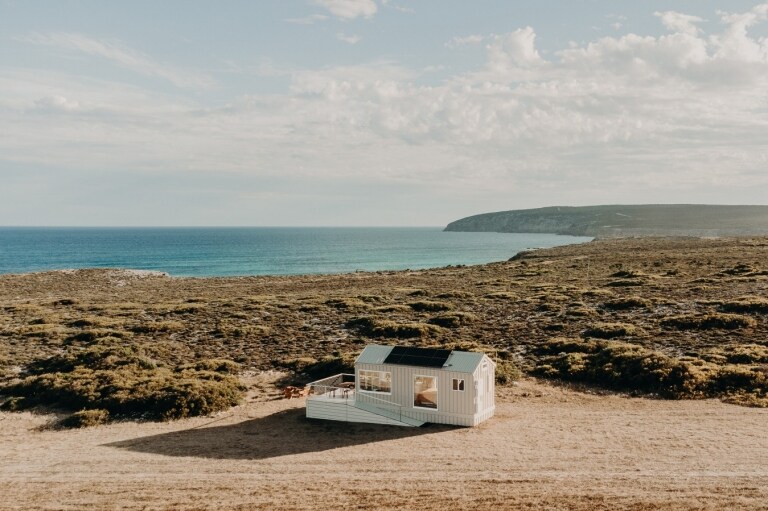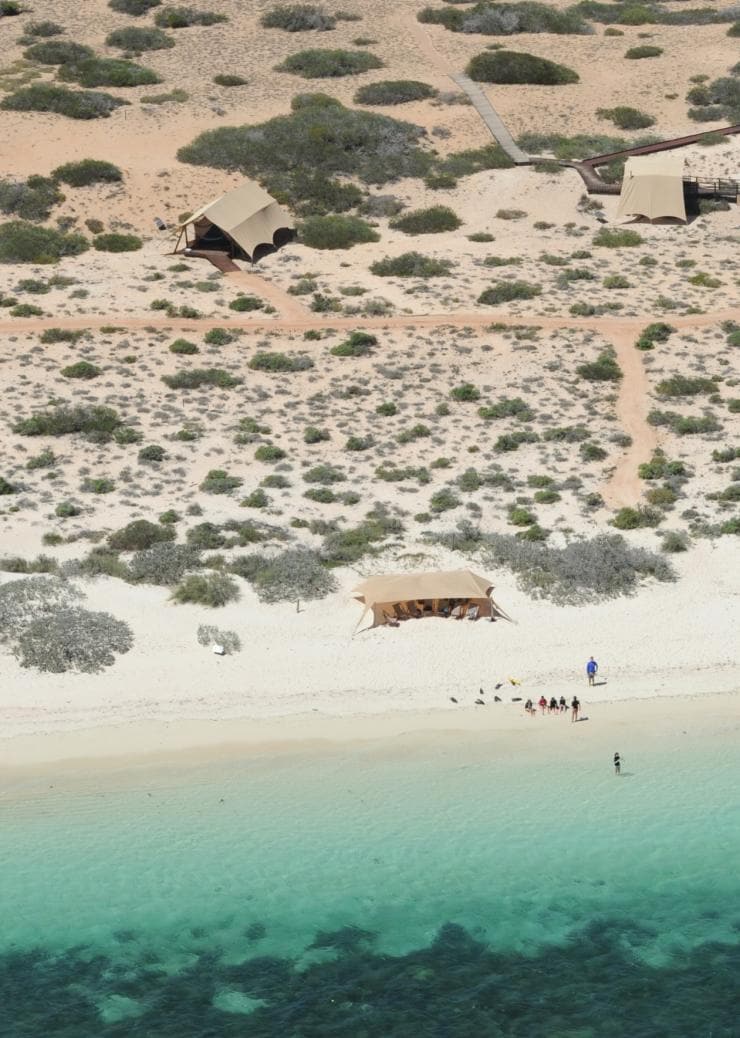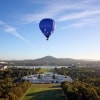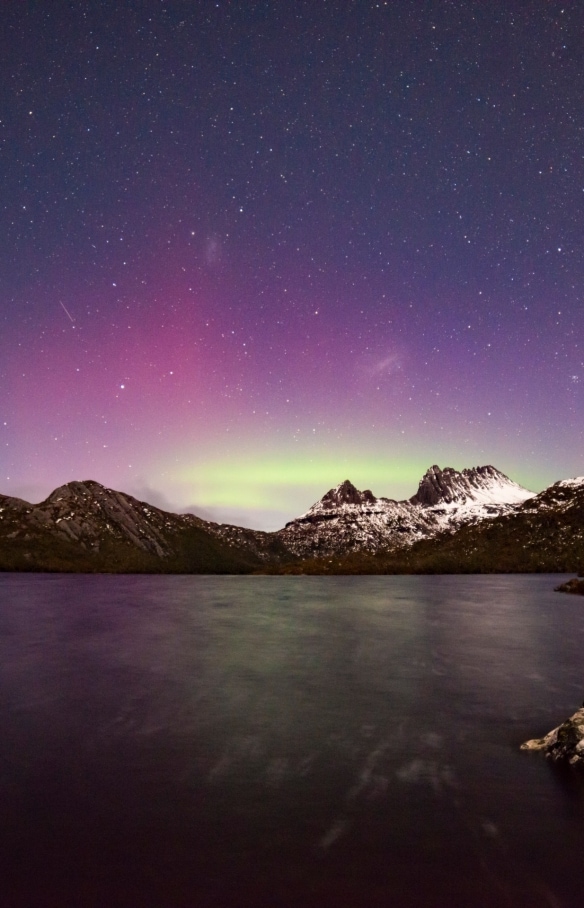
Eyre.Way Yambara, Eyre Peninsula, South Australia © Hook and Hammer Creative Media, edited By Lauren Photography
No Wi-Fi, no worries: where to go off-grid in Australia
Switch off and unwind at one of these back-to-nature escapes in Australia.
Wake up to whales at Ningaloo Reef
Wake up to whales at Ningaloo Reef
If you can live without TV and mobile phone coverage, but not without piping hot water and 500-thread count sheets, Sal Salis is your kind of bush camp. Spend your days exploring the marvels of Ningaloo Reef by snorkelling with colourful fish and floating above vibrant corals. Don’t miss the chance to swim with the world’s largest fish – the whale shark – which congregate here in large numbers from March to early August.
Sleep amid the vines outside Canberra
Sleep amid the vines outside Canberra
Just a 20-minute drive outside of Canberra, Mount Majura Vineyard takes things back to basics with its glamping option, Cubby and Co. The two tents here are named after winemakers Edgar and Frank, each one equipped with cosy basics – beds, books and board games – that let you savour the joys of good wine and company. For those who prefer four walls, Dinny (named after the vineyard’s first owner) is a charming tiny home, complete with an ensuite shower.
Find stillness on Bremer Island
Find stillness on Bremer Island
At Bremer Island's Banubanu Beach Retreat, which features glamping-style bungalows overlooking the Arafura Sea, you can relish world-class fishing and remote nature. A 15-minute flight from Gove Airport (reached by plane from Darwin) brings you to this unspoilt island. You’ll feel the slower pace straight away. Simply stroll the beaches, toss in a line and encounter nesting sea turtles.
Sleep in a deluxe geodesic dome
Sleep in a deluxe geodesic dome
Few glamping tents offer 360-degree panoramic views from the comfort of a queen size bed. But Hideaway Domes isn’t your average tent. From the outside, this eco-friendly dome looks like something from outer space, while its designer interiors evoke the warmth of home. The cool-climate wineries of Mudgee are nearby, but you’ll feel a world away as you set out on scenic walks looking for wildlife.
Unwind on a tropical island
Unwind on a tropical island
It’s not just your phone you leave at home when you head to Wilson Island – it’s the children, too. This adults-only, tech-free island on the Southern Great Barrier Reef hosts just nine glamping tents and is designed to let you slow down and rejuvenate. Start the day by snorkelling above colourful marine life, or simply lie back in a hammock while the breeze dances through the palm trees overhead.
Drift off to sleep on the Great Ocean Road
Drift off to sleep on the Great Ocean Road
If you didn’t know they were here, it would be easy to overlook the glamping tents at Pebble Point, hidden away in coastal scrub. This low-key bush retreat, 2.5 hours south-west of Melbourne, makes a great base for exploring the iconic Great Ocean Road. The majestic 12 Apostles are within walking distance; alternatively, you may decide to explore the lush Otway Ranges, or simply sit on your private deck and savour the salty sea air.
Go wild on King Island
Go wild on King Island
Just a 50-minute flight from Melbourne, King Island feels like it could be the end of the Earth. The deserted beaches, melaleuca forests and wetlands are great for hiking, but this laid-back Tasmanian island is also home to three superb golf courses and a surprisingly lively arts scene. Yet when you are holed up at Kittawa Lodge, which features two architecturally designed, oceanfront cottages, it's easy to imagine that you are the only people left on the planet.
Feel grounded on the Eyre Peninsula
Feel grounded on the Eyre Peninsula
Yambara (meaning ‘away, out of sight’ in Barngarla language) is a luxe off-grid abode that rings true to its name. Tucked away on South Australia's stunning Eyre Peninsula, this is the perfect place to reconnect with nature. The cabin’s design harnesses the region’s wilderness with floor-to-ceiling windows that reveal a white sandy beach and wildlife like kangaroos and emus.
Stargaze from your bathtub
Stargaze from your bathtub
Set on a secluded headland just a stone’s throw from Freycinet National Park, the wind- and solar-powered Thalia Haven cottage lets you immerse yourself in nature. Wake up to the sound of the sea and enjoy long walks on your own private beach before grilling up some fresh fish on the fire. Treat yourself to a long soak in the outdoor bathtub, where you can enjoy stargazing beneath the Milky Way.
Retreat to an ancient rainforest
Retreat to an ancient rainforest
The tents at the solar-powered Nightfall camp are truly luxurious. However, the camp’s real draw is its setting, nestled in the ancient rainforests of the Scenic Rim, 90 minutes from the Gold Coast. Spend the day hiking rainforest trails, enjoying a massage by the river rapids and watching for the elusive platypus in the crystal-clear creek. In the evenings, relax with a gourmet meal cooked over the open fire.










































































































































































